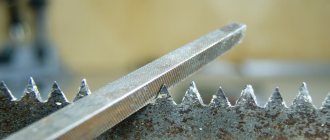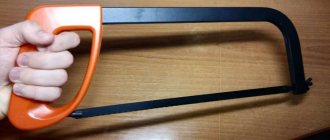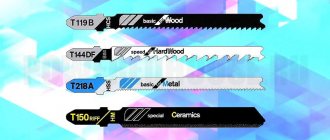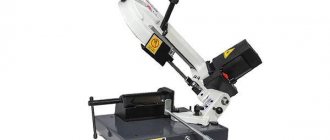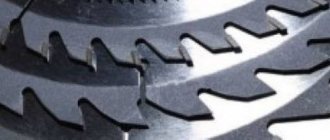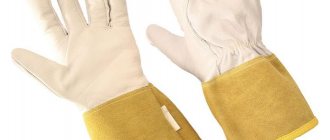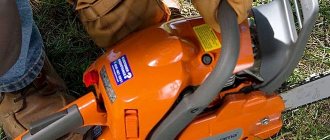Bow saws have long occupied a place of honor among carpentry tools. And although their design and design have changed significantly over the years, the basic principle of operation of these saws remains the same. What is the advantage of this tool and what makes it stand out from the rest?
What is a bow saw used for?
It is convenient to use a jigsaw to make short, mainly transverse cuts, and a hacksaw to make long, longitudinal cuts. And only with the help of a bow saw can you make a variety of dividing cuts, both with dry and wet wood. In addition, for a bow saw for wood, it does not matter how the wood is cut - along or across the grain. If we add to this the ability to work with one hand (the first “bows” were exclusively two-handed), it turns out that the tool in question can be used for cutting wood:
- in longitudinal;
- in transverse;
- in figured;
- in an angular direction.
The only insurmountable obstacle for bow saws is the transverse dimensions of the workpieces - for thick logs it is still better to use a power tool. However, you have to work much less often with thick logs...
Three circumstances give versatility to bow saws for wood:
- Adjustable tension of the saw blade (in some ways this process is similar to pulling the string of a bow, hence the name of the tool). Testing shows that bow saws can create tension forces of up to 100...120 kg without destroying the saw blade.
- The special shape of the teeth allows for both roughing and finishing cuts.
- The size of the saw is compact, which ensures its use even in cramped environments.
Modern manufacturers of bow saws and accessories for them - trademarks Bahco, Stanley, Intertool, Fiskars and others - complete their products with different types and designs of saw blades, which increases the ease of use of the tool.
What it is?
Unlike conventional wood hacksaws, saws can be used to accurately cut small workpieces at different angles relative to the direction of the grain.
Tool Features:
- Thin cutting line - thanks to a slight tooth set.
- The canvas works when moving both forward and away.
- The bow saw can be held with both hands.
- Suitable for cutting along curves.
If earlier bow saws were made of wood and they looked like large frames, now the main manufacturing material is a thin-walled steel metal pipe and a plastic handle; to improve ergonomics, the surface of the handle is covered with rubber. The mechanism for tensioning the blade is the same as that of conventional hacksaws. The type of blades is varied and differs in the number and size of cutting teeth per inch. Most often, the blade is hardened; in this case, they cannot be sharpened.
Expert opinion
Levin Dmitry Konstantinovich
Some modifications with a length of more than 500 mm can be used by two people, like two-handed saws.
The device of a bow saw for wood
The modern “onion” includes:
- Frame made of rolled profiles. Depending on the size of the saw blade - and they are usually standard: 350 mm, 530 mm or 760 mm, the frame can be made in the form of an oval trapezoid (for longer blades) or an oval triangle (for shorter ones).
- A handle whose profile prevents sudden injury to the worker’s fingers.
- Saw blade.
- Devices for tensioning saw blades.
- Fastening the canvas to the frame.
The frame of a bow saw for wood has special requirements - it must be rigid and at the same time light, so as not to increase physical stress during sawing. A special tubular profile with a very small width satisfies the task. This makes it easy to bend it during the manufacturing process to the required frame configuration without losing the strength of the part, providing the saw with the necessary mobility.
One of the main differences in the design of modern bow saws for wood is the principle of saw blade tension. For example, the Gardena or Proline brands use a handle with an eccentric for tensioning: by using it, changing the angle of inclination of the handle relative to the longitudinal axis of sawing, you can thus adjust the tension force.
Manufacturers of saws from Bahco Stanley have taken a different path: there a special screw mechanism for tensioning the saw blade is mounted in the handle. The choice is determined by ease of use, however, the presence of a screw mechanism provides increased tension accuracy, and does not depend on random movements of the user, when the position of the handle during sawing can randomly change. Therefore, it is recommended to use a rotary tension mechanism if you have some experience working with a bow saw.
To fasten the saw blade to the opposite part of the “string” (frame), removable cotter pins or wing screws are used. The latter are more reliable, since the cotter pin, usually made of mild steel, wears out over time and can spontaneously come out of the mounting hole.
How to choose a saw?
The wood saw is available in different versions on the market. How products may differ:
- Tooth shape and size;
- Canvas size;
- The grade of steel from which the working part (blade) is made;
- Handle shape.
A hacksaw with a change in one of the specified parameters can radically change its characteristics. Also, sitting comfortably in the hand of one master, it will not suit another at all. These factors must be taken into account when choosing a tool for different purposes.
Teeth size
This parameter affects the quality and speed of work. To make it easier to determine the size and number of teeth, the designation TPI was introduced, indicating the number of teeth in one inch. This parameter can be seen in the description of a hand saw for wood; the value is often written on the blade.
- A wood saw with a large tooth produces a rough cut at high speed. It is useful for cleaning the area from branches, cutting boards for firewood and other activities where you can get by with the rough ends of products and trunks. For such instruments, the tooth size TPI 3...6 is selected.
- For products that need to be cut neatly and evenly, a fine-tooth hacksaw with TPI 7...9 is suitable. This type is used for sawing fiberboard, chipboard, laminate, and in repair work. The productivity of such a tool is significantly lower than that of a coarse-toothed one.
A carpenter's saw is selected primarily based on the size of the tooth. So, for ordinary wood, small and large are suitable, but for “delicate” materials such as fiberboard, a fine-toothed saw is needed. In stores you can now find similar designations: “for wood”, “for drywall”, etc. Their main difference is the size of the teeth, which is optimal for sawing each of the materials indicated on the label.
The teeth are distinguished by shape, depending on this the tool acquires different purposes:
- The hacksaw for longitudinal sawing is equipped with triangular teeth with oblique angles. Their appearance resembles hooks that are sharpened on both sides. Because of this, the saw slides along the wood fibers and cuts the blade smoothly, almost without jagged edges.
- The crosscut tool is equipped with teeth in the shape of an isosceles triangle. A mechanical hacksaw of this type cuts as it passes back and forth, but it can only be used for processing dry wood.
- A manual hacksaw for mixed sawing is equipped with both types of teeth alternately located one after the other.
Long curved saws the material in the forward direction; in the reverse movement, the triangles expand the channel for passage and catch shavings and sawdust behind them. In modern models, teeth alternate with voids. This allows you to use the saw on dry and freshly cut wood; coarse unnecessary fibers are removed through the holes.
Steel selection
To make the tool last longer, you should choose high grades of steel for the production of the blade. It's better if it's stainless.
The teeth can be hardened or regular. Regular saws can be sharpened at home, saws with hardened teeth are disposable, and once worn out, nothing can be done with them. They are easy to recognize by their dark color as in the photo.
Blade length
This parameter is determined by the size and pitch of the saw tooth.
- A mini-hacksaw is always equipped with small, frequent teeth; the length of its blade does not exceed 350 mm;
- A universal hacksaw has an average tooth size and a length of no more than 550 mm;
- The wide hacksaw is equipped with large teeth with an increased pitch, the length of its blade is over 600 mm.
In addition to the length, the canvas can vary in shape. A traditional saw has the shape of a rectangle narrowed on one side. This is a universal type of tool that can be used to cut anything.
The rounded blade is adapted for working with branches and other objects at a distance: it is lightweight and easily glides along the wood without much effort.
Handle shape
This part of the saw determines the ease of work. The tool should fit perfectly into your hand and be comfortable. Various plastics that are pleasant to the body are used to make handles.
An important note: the material should not slip if your hand suddenly becomes sweaty. For this purpose, the handle body has recesses and grooves, a rubberized pad
Bow saw blade
The versatility of this tool also determines changes in the design of the saw blade, in particular its teeth. Most often used:
- Saw blades with uniform tooth pitch. They are designed for smooth cutting of wood with a relatively short length.
- Canvases with the so-called “American” tooth, when after 3..4 ordinary teeth there is a double or “Kremlin” tooth. This configuration of the cutting part of the saw blade allows for longer and more complex cuts. The frequency of alternation determines the accuracy of the result: the closer the double teeth are located to each other, the less clean the cutting line will be.
- Spatial teeth with wide spacing. A blade with such teeth is useful for maximum cross-sectional sizes of wood being cut. The cutting force and the amount of waste increase, but sawing productivity becomes the highest possible.
Comparison with a hacksaw
This tool is used to implement longitudinal sawing. The saw has a special beam in which the saw blade is stretched. The bow itself contains 2 stands and handles, as well as a spacer, a tension string and a fixing twist. Sometimes, as a substitute for twisting, you can find a screw with a nut connected to a metal bowstring in the design. There are circular bow saws used for cutting along a curved line.
Speaking about comparing a regular saw (two-handed or hacksaw) with a bow saw, it is worth noting a number of advantages over a regular saw:
- a bow saw will help make a more even and accurate cut
- during work you will put in much less effort than when working, for example, with a hacksaw. in certain cases, even two people can work with a bow, which is impossible when working with a hacksaw
- simple maintenance. Bow saw blades do not require turning, setting or adjusting. A worn file just needs to be replaced with a new one.
- The blade of a bow saw, clamped in the place of the cut, almost never jams. Yes, it is possible that the movement of the saw is sometimes difficult, however, it does not “chew” the saw tightly, as is often the case with conventional saws.
Despite their external similarity, bow saws from different manufacturers are radically different from each other. For example, there are differences in almost all the structural components of the tool - these are different shapes of the beam or handle, different methods of fixing and tensioning the blades, as well as their tension.
What is it and what is it for?
A bow saw can easily be defined as an outdated device. But even if you have the entire necessary set of power tools stored at home, there may be many situations when you cannot do without a hand-held bow saw. If we consider the main purpose of this tool, it is worth noting that this kind of device is intended for accurate sawing of metal parts, as well as for working with wooden surfaces.
A bow saw can be used to make various parting cuts with any type of wood. We must not forget that for a product intended for cutting wood, the method of cutting it – lengthwise or crosswise – does not matter. There is also the ability to work with only one hand. This tool can be easily selected for cutting wood: in the longitudinal direction, as well as in the transverse and figured, even in the angular direction. True, for thick logs it is better to choose a more serious tool.
If we compare a standard saw with two handles with a bow saw, we should highlight the following positive features over the classic product:
- a bow tool will allow you to make a much more beautiful cut;
- you will spend much less effort - sometimes you can work with a bow and a pair, which will not work when working with a hacksaw saw;
- easy care.
Design features
This kind of saw is called a bow saw for the reason that its structure will be as elastic as that of a combat bow. At its core is a machine made of high-quality racks. There are 3 racks in total - 2 on the sides and 1 placed horizontally. Racks are most often made of hardwood. At the bottom of the vertical posts there are similar holes for attaching handles to them. The horizontal stand is called the mullion.
The working handle can be called a real piece of carpentry art, since the convenience of working and the percentage of its productivity will directly depend on its quality. The handles are most often round in shape; at the end there are cuts and special holes for installing the working blade.
There are several original varieties of bow saws.
- Folding bow saw , which is simply an indispensable accessory on hikes, which involve independently constructing a resting place using trees adjacent to the camp. Most often it is called hiking or tourist. Some manufacturers develop this kind of tool specifically in order to use it in difficult conditions. The main feature of this saw is its folding design. The product will actually quickly fold and unfold, and will not require additional tools or serious effort.
- Hand-held bow saw for wood. Before you start working, you will need to carefully examine the product itself and find out for yourself that there are no defects on those parts of the racks that are made of durable wood, and that the canvas is intact.
- Bow saw for metal. Before purchasing a specific tool, find out exactly what material you will need to process. After this, it will be possible to choose the most convenient shape for the work, as well as the length and width of the teeth, and the speed of movement of the device.
Important! The best option would be to purchase a product made of hardened steel - this is a 100% guarantee of its strength and long service life.
How to choose a saw?
The wood saw is available in different versions on the market. How products may differ:
- Tooth shape and size;
- Canvas size;
- The grade of steel from which the working part (blade) is made;
- Handle shape.
A hacksaw with a change in one of the specified parameters can radically change its characteristics. Also, sitting comfortably in the hand of one master, it will not suit another at all. These factors must be taken into account when choosing a tool for different purposes.
Teeth size
This parameter affects the quality and speed of work. To make it easier to determine the size and number of teeth, the designation TPI was introduced, indicating the number of teeth in one inch. This parameter can be seen in the description of a hand saw for wood; the value is often written on the blade.
- A wood saw with a large tooth produces a rough cut at high speed. It is useful for cleaning the area from branches, cutting boards for firewood and other activities where you can get by with the rough ends of products and trunks. For such instruments, the tooth size TPI 3...6 is selected.
- For products that need to be cut neatly and evenly, a fine-tooth hacksaw with TPI 7...9 is suitable. This type is used for sawing fiberboard, chipboard, laminate, and in repair work. The productivity of such a tool is significantly lower than that of a coarse-toothed one.
A carpenter's saw is selected primarily based on the size of the tooth. So, for ordinary wood, small and large are suitable, but for “delicate” materials such as fiberboard, a fine-toothed saw is needed. In stores you can now find similar designations: “for wood”, “for drywall”, etc. Their main difference is the size of the teeth, which is optimal for sawing each of the materials indicated on the label.
The teeth are distinguished by shape, depending on this the tool acquires different purposes:
- The hacksaw for longitudinal sawing is equipped with triangular teeth with oblique angles. Their appearance resembles hooks that are sharpened on both sides. Because of this, the saw slides along the wood fibers and cuts the blade smoothly, almost without jagged edges.
- The crosscut tool is equipped with teeth in the shape of an isosceles triangle. A mechanical hacksaw of this type cuts as it passes back and forth, but it can only be used for processing dry wood.
- A manual hacksaw for mixed sawing is equipped with both types of teeth alternately located one after the other. Long curved saws the material in the forward direction; in the reverse movement, the triangles expand the channel for passage and catch shavings and sawdust behind them. In modern models, teeth alternate with voids. This allows you to use the saw on dry and freshly cut wood; coarse unnecessary fibers are removed through the holes.
Steel selection
To make the tool last longer, you should choose high grades of steel for the production of the blade. It's better if it's stainless.
The teeth can be hardened or regular. Regular saws can be sharpened at home, saws with hardened teeth are disposable, and once worn out, nothing can be done with them. They are easy to recognize by their dark color as in the photo.
Blade length
This parameter is determined by the size and pitch of the saw tooth.
- A mini-hacksaw is always equipped with small, frequent teeth; the length of its blade does not exceed 350 mm;
- A universal hacksaw has an average tooth size and a length of no more than 550 mm;
- The wide hacksaw is equipped with large teeth with an increased pitch, the length of its blade is over 600 mm.
In addition to the length, the canvas can vary in shape. A traditional saw has the shape of a rectangle narrowed on one side. This is a universal type of tool that can be used to cut anything.
The rounded blade is adapted for working with branches and other objects at a distance: it is lightweight and easily glides along the wood without much effort.
Handle shape
This part of the saw determines the ease of work. The tool should fit perfectly into your hand and be comfortable. Various plastics that are pleasant to the body are used to make handles.
An important note: the material should not slip if your hand suddenly becomes sweaty. For this purpose, the handle body has recesses and grooves, a rubberized pad
Rating of the best models
Although they are similar in appearance, bow saws will differ significantly from different brands. For example, there will be differences in almost the entire structure of this instrument - from different bow designs or comfortable handles, to different fixation techniques, as well as different string tension.
- Bow saw from the Proline brand. It is useful for different types of cuts, including figured ones. It has a durable beam with a tightly stretched fabric. The bow will have 2 strong stands, special spacers, and there will also be a tension type bowstring. The length of this product is 760 mm, which will allow it to cut medium-sized logs.
- Product from Stanley Raker Tooth. It is perfect for working with not very large pieces of wood. The oval-shaped cross-section of the steel frame guarantees this product increased durability. There is a lever here with which you can properly tension the fabric and quickly change it if necessary. The saw is made of a special type of steel – hardened. The teeth here will have a shape that is commonly referred to as American - they do not require sharpening or constant care. This tool copes well with dry wood and completely fresh materials.
Subtleties of choice
It is worth paying attention to the main features of choosing a saw blade.
- When selecting or purchasing a bow saw, you need to take a special look at its main parameters - whether you have chosen the right blade size, whether its stability, thickness, and fastening method satisfy you.
- Choosing the most suitable length of the product canvas is quite simple - you just need to know the length of its frame. The parameters of the frame may differ - it can be 350 mm long, and can also have a length of 500 mm or 700 mm or more. The length measurement system that will be used is also important - it can be in inches or centimeters. If the size of your saw is calculated in inches, then you need to select a blade for it, whose length is calculated in the same parameters.
- It is important what material the product is made of. Several types of steel can be selected here. Saw teeth are often coated with a special Teflon coating to prevent corrosion or other negative processes that appear due to the influence of the environment surrounding the tool.
- The shape of the blade teeth is a special characteristic when selecting a product blade. It can have different shapes - trapezoid or triangle, “Kremlin” shape. An important feature of blades for archery woodworking can be considered the fact that it will have a different number of teeth per 1 inch (or centimeter) of blade. This indicator will allow you to get a more accurate cut. The greater the number of teeth per 1 inch of blade, the more beautiful the cut will be, and if there are few teeth, then the cut will be rough.
Safety precautions at work
To make working with a bow product as comfortable and safe as possible, you need to consider the following tips:
- place the blade only in separate slots located in the handle, and secure it in the required holes with special dowels;
- place the product near your chest so that the bowstring practically touches the body itself, and visually inspect the location of the canvas in the most careful way - so that it becomes perpendicular to your line of sight;
- by accurately turning the handle, you can easily achieve an even position of the blade with teeth in special holes;
- after the canvas is adjusted, you should, carefully turning the arrow, tighten the string and stretch the racks in order to secure the canvas more firmly;
- You should not sharpen or straighten blades for this type of product without the help of a specialist if you do not have professional skills; It is best to immediately purchase sharp factory blades;
You should not be distracted when working with such a saw; you should not leave the saw sticking out in the material while resting, so as not to spoil the blade, and it will be extremely difficult to start working again from this position.
To learn how to choose the right bow saw and how to use it, watch the following video.

